Coconut Milk Chicken That Will Blow Your Mind
Coconut Milk Chicken is more than a comforting recipe it’s a creamy Thai experience that turns an everyday chicken dish into something unforgettable. At JustThaiRecipes, we live for meals like this simple to cook, yet loaded with the rich, aromatic flavors of Thailand.
Our About Page tells the real story behind this dish. JustThaiRecipes began as a passion project by Lina and her partner, who fell in love with Thai cuisine while traveling and cooking across Southeast Asia. Inspired by Bangkok’s bustling street food and cozy family kitchens in Chiang Mai, Lina returned with one mission: to help home cooks create authentic Thai flavors with ingredients they already know.
So, when we say this Coconut Milk Chicken recipe is the perfect example of our philosophy, we mean it. You only need a handful of pantry staples: boneless chicken, unsweetened coconut milk, some spices, and herbs. What you get is a beautifully spiced, velvety chicken dish that you’ll want to make over and over again. It’s the kind of recipe that becomes a weeknight favorite but also impresses guests at your dinner table.
In this article, you’ll learn exactly how to cook this savory, creamy dish from scratch, marinate it like a pro, customize the heat level, and pair it with perfect Thai sides. We’ll also dive into common questions like Is coconut milk good on chicken? and How long should you marinate chicken in coconut milk?
Looking for inspiration? Try Homemade Thai Coconut Curry Meatballs—another delicious way to enjoy coconut milk with proteins.
Let’s start with why coconut milk chicken is so universally loved across cultures and kitchens.
Table of Contents
Table of Contents
Why Coconut Milk and Chicken Are a Perfect Match
The Nutritional and Cooking Benefits of Coconut Milk Chicken
Coconut milk isn’t just creamy and rich—it’s also surprisingly healthy. Packed with healthy fats (MCTs), coconut milk helps the body absorb fat-soluble vitamins and enhances satiety. When paired with lean chicken breast or thighs, it creates a nutrient-dense, high-protein, low-carb meal.
Coconut milk is also lactose-free, making it ideal for dairy-free recipes. For people with food sensitivities or those following paleo or Whole30 diets, this dish becomes a go-to comfort meal without sacrificing flavor.
Not to mention, coconut milk is a great carrier for spices. It balances the heat of cayenne, complements the earthiness of cumin, and adds a gentle sweetness to acidic tomatoes. That balance is what makes coconut milk chicken stand out in so many global kitchens.
If you’re a fan of creamy dishes, don’t miss our Coconut Mango Chicken Curry—a vibrant, tropical variation that blends sweet and spicy notes beautifully.
Texture and Flavor Profile: Why It Works So Well
When you cook chicken in coconut milk, the result is tender, flavorful meat with a juicy texture. The fats in the milk lock in moisture, especially during simmering, so you avoid that dreaded dry chicken problem.
The combination of cumin, paprika, oregano, and garlic in this recipe forms a robust flavor base. When these spices bloom in olive oil, then melt into the coconut milk, they create a velvety, reddish-orange sauce that clings to every piece of chicken.
For those wondering about variations like best coconut milk chicken curry or simple coconut chicken recipe with coconut milk, this is your foundational method. From here, you can pivot toward Indian, Asian, or fusion profiles by tweaking just a few ingredients—like using ginger or adding green curry paste.
Don’t miss our Thai Chicken Bites if you love sticky, bold chicken dishes.
Regional Styles: From Thailand to India
In Thai cuisine, coconut milk is a staple used across everything from curries to soups. In India, it often appears in southern dishes, where it’s paired with mustard seeds, turmeric, and tamarind.
In this recipe, we pull from both styles—using tomatoes and garlic (more Indian) but finishing with lime and cilantro (distinctly Thai). That hybrid flavor makes the dish more flexible to serve with either jasmine rice, naan, or even a crusty loaf of bread.
Chicken with coconut milk Indian-style often includes cardamom, cloves, and sometimes cinnamon. You can easily modify this recipe for that version by sautéing whole spices at the start and replacing tomato paste with a splash of yogurt or ghee.
But no matter the style, the base always remains the same—coconut milk and chicken, a duo that delivers every time.
Want to pair this meal with a sweet, tropical dessert? Try Thai Mango Sticky Rice—a classic favorite that finishes your dinner on a perfect note.
Key Ingredients for the Best Coconut Milk Chicken
Why Ingredient Quality Matters
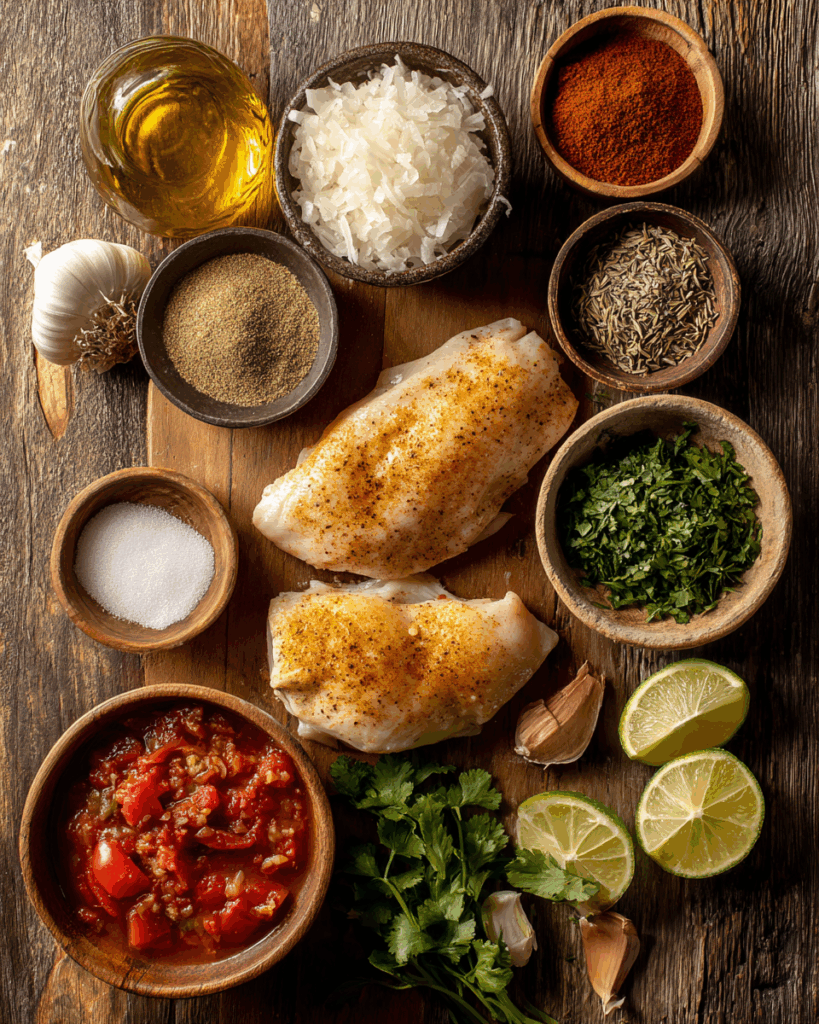
Creating a delicious Coconut Milk Chicken starts with choosing the right ingredients. High-quality, fresh ingredients don’t just enhance flavor—they ensure texture, aroma, and nutrition are preserved from pan to plate. With coconut milk, in particular, cheap brands can lead to watery sauces and separation during cooking. Go for full-fat, unsweetened versions to get that silky, rich mouthfeel.
Chicken selection is equally important. While you can use chicken thighs or chicken breast, they cook differently. Thighs are juicier, forgiving, and flavorful—making them great for longer simmering. Breasts offer lean protein and cook quicker. Choose based on the texture you prefer.
Essential Ingredients Breakdown
Let’s look at each element in the coconut milk chicken recipe and what it brings to the table:
| Ingredient | Purpose |
|---|---|
| 1.5 lbs boneless, skinless chicken breasts | Protein base; absorbs flavors from spices and sauce |
| 1 tsp ground cumin | Earthy warmth; enhances the coconut milk’s sweetness |
| 1 tsp smoked or sweet paprika | Adds smoky depth or gentle sweetness |
| 1 tsp dried oregano | Boosts aroma and earthy tones |
| ½ tsp cayenne pepper | Heat; can be adjusted to taste |
| 1–1½ tsp salt | Essential flavor enhancer |
| ¼–½ tsp black pepper | Balances flavor and spice |
| 3 tbsp olive oil | Fat for sautéing and blooming spices |
| 1 small yellow onion | Builds the aromatic base |
| 3 cloves garlic | Adds punch and depth |
| 1 tbsp tomato paste | Concentrated umami; adds body to the sauce |
| 2 cups diced tomatoes | Adds acidity and richness |
| 14 oz can of unsweetened coconut milk | The creamy star of the dish |
| Fresh cilantro | Herbaceous, bright garnish |
| Lime wedges | Cuts through creaminess; enhances Thai flavor balance |
Don’t forget to shake and stir the coconut milk before using. Coconut solids often separate in the can.
If you’re in the mood for variety, this base works well with chicken thighs too. Simply extend the simmer time by 5–8 minutes for tender, juicy results.
Optional Enhancements to Elevate Flavor
- Fresh ginger (grated): Adds zing and supports digestion
- Lemongrass (bruised): Boosts Thai authenticity
- Fish sauce (a few drops): Introduces umami depth
- Brown sugar or palm sugar (½ tsp): Balances spice if using cayenne
Using these tweaks, you can build variations like chicken with coconut milk Indian, or simple coconut chicken recipe with coconut milk tailored to your preference.
Step-by-Step Cooking Instructions for Coconut Milk Chicken
Preparing and Seasoning Your Chicken
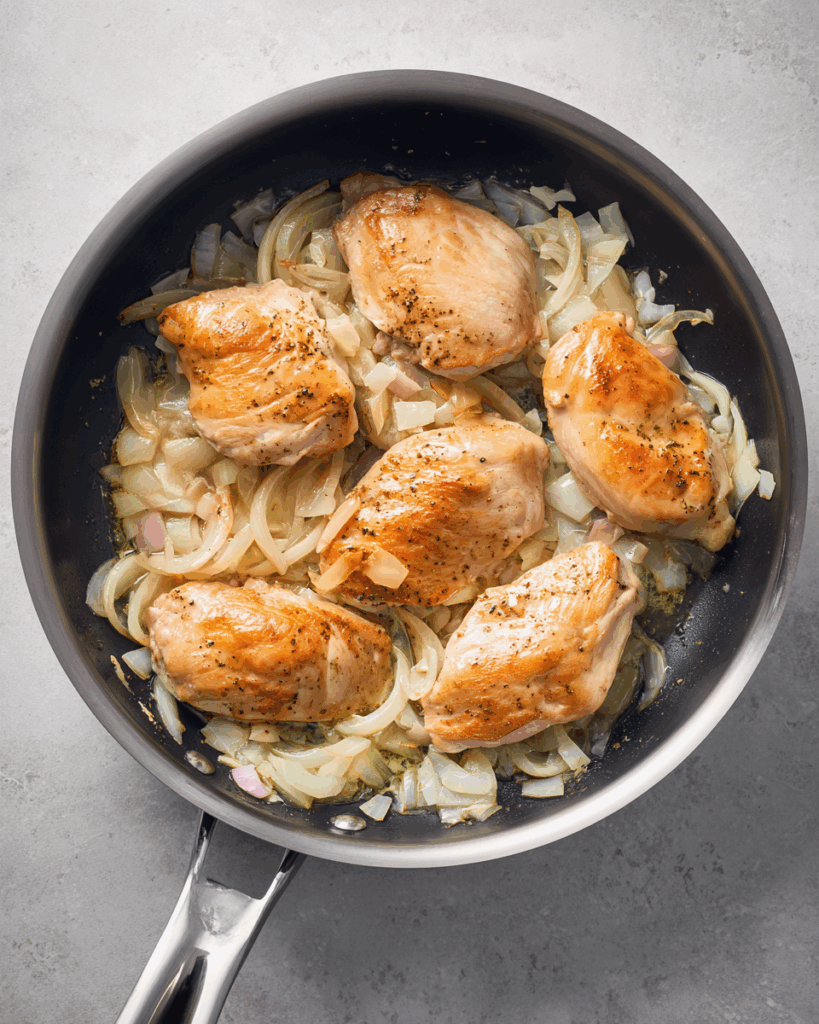
Start by patting your chicken breasts dry with a paper towel—this helps spices adhere and allows the meat to sear properly. Slice the chicken into even 1 to 1½-inch thick pieces. Even thickness ensures your chicken cooks evenly and stays juicy.
In a small bowl, mix together the seasoning blend:
- 1 teaspoon ground cumin
- 1 teaspoon paprika (smoked or sweet)
- 1 teaspoon dried oregano
- ½ teaspoon cayenne pepper (optional for heat)
- Salt and pepper to taste
Rub this mixture generously all over your chicken. Let it sit for 10–15 minutes while you prep the rest of the ingredients. If you’re planning ahead, marinate it in the fridge with the spices and 2 tablespoons of coconut milk for up to 2 hours for extra depth.
This method is similar to the flavorful prep used in Thai Coconut Chicken, where layered spices meet creamy sauces for bold flavor.
Cooking the Sauce and Building Flavor
In a large skillet, heat 2 tablespoons of olive oil over medium heat. Sear the seasoned chicken on each side for 6–7 minutes until lightly browned and almost cooked through. Remove the chicken and set it aside on a plate, covering it loosely with foil.
In the same skillet, add the remaining tablespoon of olive oil. Toss in the finely diced yellow onion and sauté for 2–3 minutes until softened. Add minced garlic (3 cloves) and stir for 20 seconds to release the aroma.
Now stir in 1 tablespoon of tomato paste. Let it caramelize slightly before adding your diced tomatoes (fresh or canned). Cook this mixture for 4–5 minutes, allowing it to thicken and soften.
Finally, pour in your 14-ounce can of unsweetened coconut milk—shake the can before opening. Stir gently, bring the mixture to a light simmer, and let it cook down for about 5 minutes until the sauce begins to thicken slightly.
For more creamy skillet options, see this One Skillet Coconut Lime Chicken for a zesty twist.
Final Simmer and Plating Tips
Once the sauce has thickened, return your seared chicken to the pan. Reduce the heat to medium-low and let it simmer in the coconut sauce for another 4–6 minutes until the chicken is fully cooked and its internal temperature reaches 165°F.
Taste the sauce and adjust salt or pepper if needed. For a pop of brightness, squeeze a bit of lime juice over the chicken just before serving. Garnish with chopped fresh cilantro or parsley.
Plate your coconut milk chicken over steamed jasmine rice or alongside warm naan for an easy, comforting meal. The sauce is rich enough to enjoy spooned over rice, noodles, or even roasted vegetables.
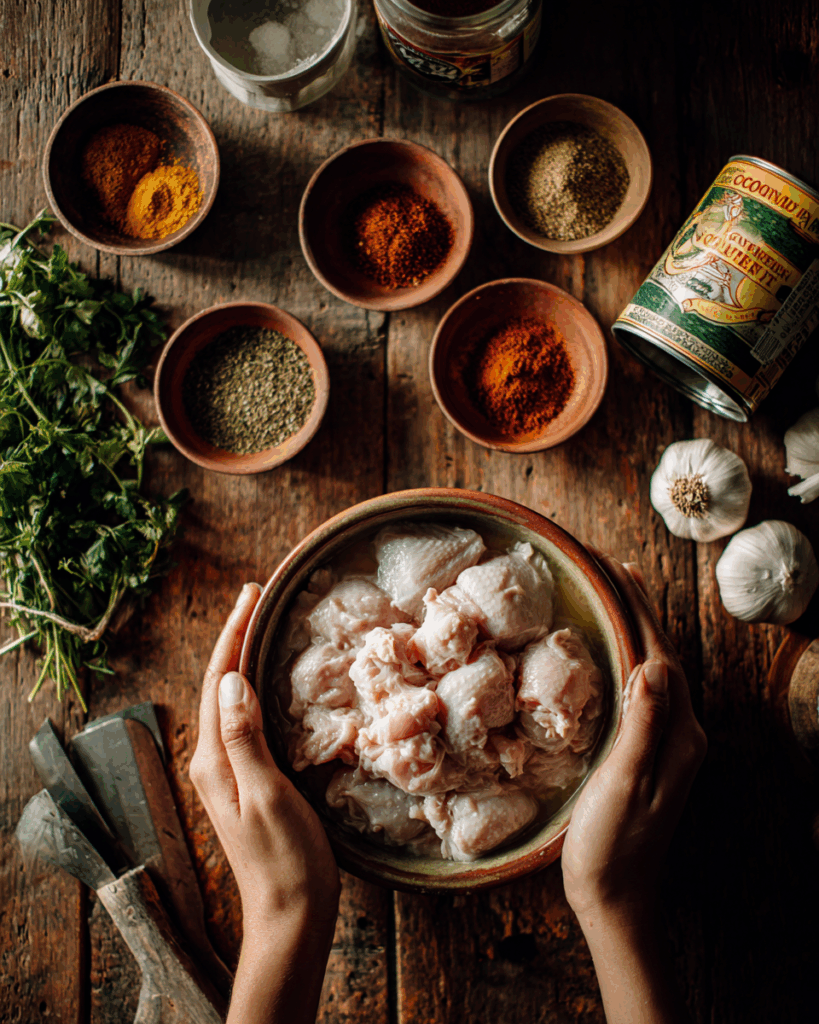
Looking for a crunchier take? This Crunchy Coconut Chicken offers a breaded variation you can try on a different night.
For quick weeknight meals, check out this Quick Coconut Chicken Curry—it’s perfect if you’re craving bold flavor in under 30 minutes.
Tips to Customize Your Coconut Milk Chicken
Adjusting Spice Levels and Heat
One of the best things about coconut milk chicken is how easy it is to customize based on your personal spice tolerance. The original recipe includes cayenne pepper, which gives the dish a gentle kick. If you’re a fan of bold, spicy flavors, you can increase the cayenne to 1 teaspoon or even add sliced Thai chilies or a dash of chili garlic sauce for extra heat.
Prefer a mild version? Simply skip the cayenne altogether or replace it with a pinch of sweet paprika for color without the heat. The coconut milk naturally balances out spice, so even a hotter variation won’t feel overwhelming. This dish is great for families because you can easily divide the sauce and adjust the heat for different taste preferences.
For a more herbaceous flavor rather than heat, consider adding fresh basil, lemongrass, or grated ginger during the simmering stage. These ingredients add a unique flavor dimension without making the dish spicy.
Using Chicken Thighs vs. Breasts
This recipe works beautifully with both chicken breasts and chicken thighs, but there are key differences you should know when choosing which one to use.
- Chicken Breasts: These are lean and cook quickly. They work best for a lighter version of coconut milk chicken. To avoid dryness, avoid overcooking—keep the sear under control and monitor the internal temperature closely.
- Chicken Thighs: These are fattier and more forgiving, making them ideal for beginners or for those who want richer flavor. Thighs become incredibly tender when simmered in coconut milk and soak up more of the creamy sauce.
If using thighs, extend the cooking time by about 5–8 minutes during the simmering stage to ensure they’re fully cooked. Boneless thighs are easiest to handle, but bone-in can also be used if you’re comfortable adjusting cook times.
Thighs tend to pair well with stronger seasonings and extra garlic or onion, while breasts are best for a balanced, clean flavor.
Making It Gluten-Free, Dairy-Free, or Low-Carb
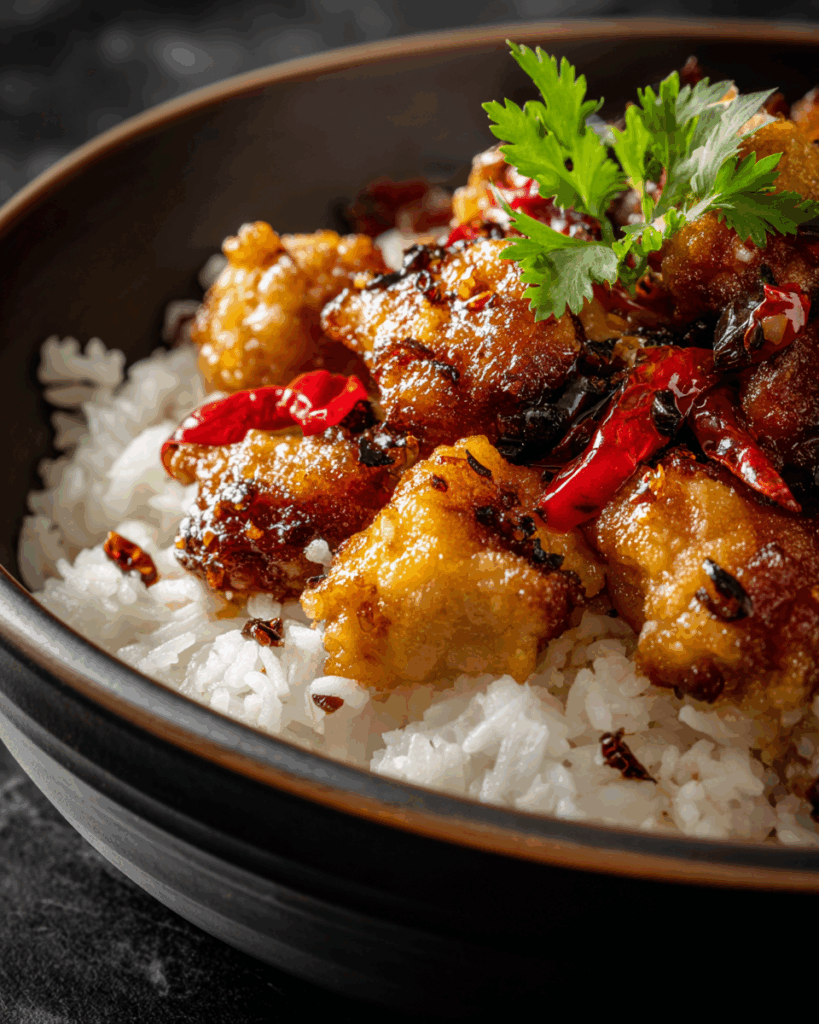
This coconut milk chicken recipe is naturally dairy-free because coconut milk replaces cream or cheese. It’s perfect for anyone who is lactose-intolerant or following a dairy-free diet.
To keep the dish gluten-free, ensure your tomato paste and any seasoning blends are certified gluten-free. Most spices are naturally gluten-free, but it’s always wise to double-check the labels, especially if you’re cooking for someone with celiac disease or a gluten sensitivity.
Want to make it low-carb or keto-friendly? Skip serving it with rice or naan and instead pair it with:
- Steamed broccoli or cauliflower rice
- Zucchini noodles
- Stir-fried spinach or kale
- A crisp Thai cucumber salad
Because coconut milk is low in carbs and high in healthy fats, this dish fits beautifully into a keto or paleo meal plan with just a few side adjustments.
You can also increase the protein content by adding chickpeas or white beans (if not keto), or mix in baby spinach toward the end of cooking for added nutrients without changing the flavor.
This level of flexibility makes coconut milk chicken a reliable option for meal prep, special diets, and weeknight cooking. It’s proof that a comfort meal can still be healthy and satisfying.
Serving Suggestions and Side Pairings
Perfect Sides to Serve with Coconut Milk Chicken
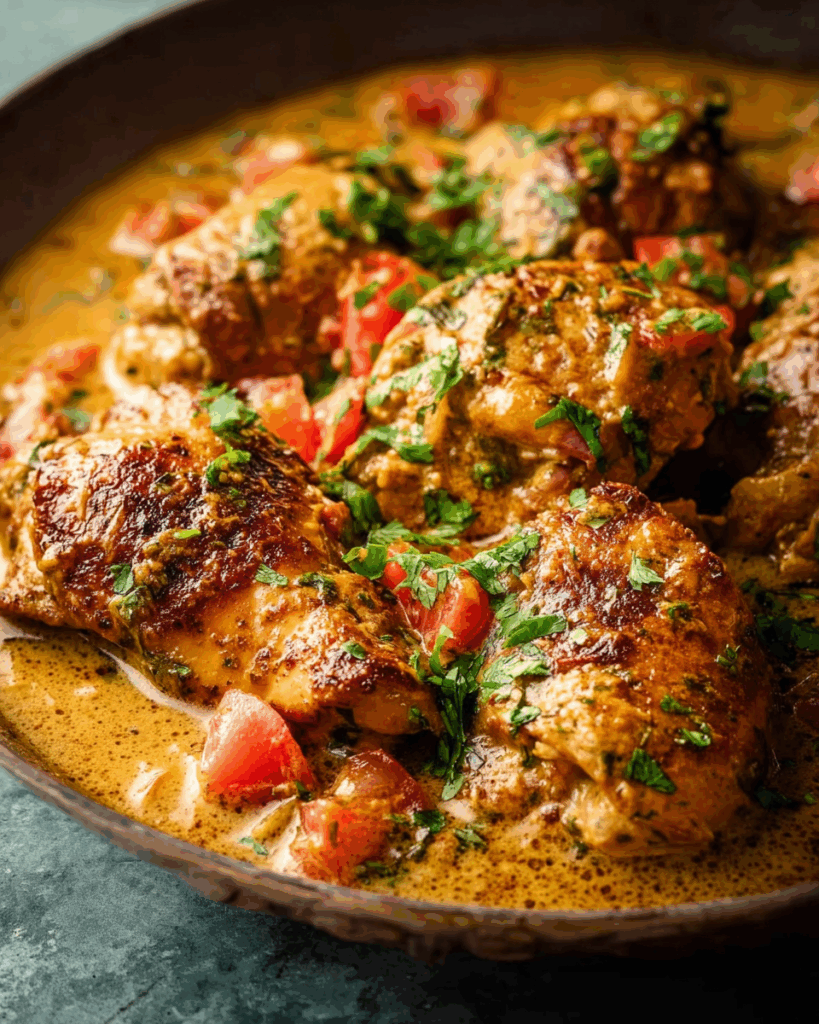
When it comes to rounding out your plate, Coconut Milk Chicken is incredibly versatile. Its rich, creamy, and mildly spiced sauce pairs beautifully with a wide range of sides, from traditional Thai staples to low-carb options.
If you want a classic Thai-inspired experience, serve Coconut Milk Chicken over a bed of steamed jasmine rice. The fluffy rice soaks up the silky coconut sauce, making every bite flavorful and satisfying. For even more aroma, try it with Thai sticky rice, especially if you’re garnishing with cilantro and lime.
For something a little lighter, opt for cauliflower rice or zucchini noodles. These keep the meal low-carb while still letting the flavors of the chicken and coconut sauce shine.
Other excellent side options include:
- Garlic sautéed green beans or snow peas for crunch
- Crispy Thai spring rolls or vegetable dumplings
- A tangy green papaya salad to add contrast
- Roasted sweet potatoes for a sweet and savory balance
Because Coconut Milk Chicken is packed with flavor, your sides can be simple. Just a sprinkle of sesame seeds or a light drizzle of soy or lime dressing can elevate even basic steamed vegetables.
How to Garnish and Finish for Presentation
Presentation might not change the taste of Coconut Milk Chicken, but it absolutely enhances the experience. After simmering, spoon the chicken and sauce over your chosen base, making sure each plate has plenty of that creamy, spiced coconut gravy.
Finish each dish with:
- A generous sprinkle of fresh cilantro or parsley
- Lime wedges on the side for brightness
- A dash of crushed red pepper or thin chili slices if you like it spicy
- Toasted coconut flakes for texture and a nutty aroma
If you’re serving for guests or a special dinner, garnish each plate individually instead of the skillet—it gives a polished look and makes the dish feel more special.
The bright green herbs and bold orange hue of the coconut sauce make this dish pop visually. Whether you’re cooking for your family or photographing your dish, these final touches matter.
Making It Part of a Complete Thai-Inspired Meal
Want to turn your Coconut Milk Chicken into a full Thai-style dinner? Build your menu around balance—pair creamy richness with spice, crunch, and freshness.
Here’s how you could plan it:
- Starter: Begin with a light Thai cucumber salad or small shrimp rolls.
- Main Course: Serve your Coconut Milk Chicken with jasmine rice or Thai noodles.
- Side Dish: Add a stir-fried vegetable medley or lemongrass soup.
- Dessert: End with a bowl of mango sticky rice or coconut tapioca pudding.
You can even use this dish as a base for meal prep—cook a double batch, store it in airtight containers, and enjoy throughout the week. The sauce thickens beautifully overnight, making leftovers even more flavorful.
Whether you’re planning a laid-back dinner or a weekend Thai feast, Coconut Milk Chicken fits right in. It brings comfort, richness, and a hint of exotic warmth that keeps everyone coming back for more.
Common Mistakes to Avoid When Making Coconut Milk Chicken
Overcooking the Chicken
One of the most frequent missteps when preparing Coconut Milk Chicken is overcooking the meat. Whether you’re using chicken breasts or thighs, cooking past the optimal temperature will lead to dry, chewy results—something no one wants, especially in a dish known for its creamy tenderness.
The key is to sear the chicken just until browned, not fully cooked, during the first stage. Once it simmers in the coconut milk sauce, it finishes cooking gently, absorbing flavor and staying juicy. Always check the internal temperature with a thermometer. The chicken is safe to eat once it reaches 165°F at the thickest part.
If you don’t have a thermometer, a simple way to check doneness is by slicing into the center. It should be white, not pink, and juices should run clear. But be careful—slicing too early releases moisture, so limit checking to once.
To avoid overcooking:
- Don’t walk away from the pan during the sear.
- Reduce heat once you add the coconut milk.
- Let it simmer gently instead of boiling.
This step ensures that your Coconut Milk Chicken turns out moist, tender, and full of flavor every time.
Using the Wrong Type of Coconut Milk
Not all coconut milk is created equal, and using the wrong type can completely change the outcome of your dish. For Coconut Milk Chicken, it’s essential to use full-fat, unsweetened canned coconut milk.
Avoid:
- Coconut milk beverages (found in cartons near dairy alternatives) — they are watered down and lack the richness needed for sauces.
- Sweetened coconut milk — commonly used in desserts and will throw off the savory balance of this dish.
- Low-fat coconut milk — it won’t thicken properly and can lead to a watery, separated sauce.
Always shake the can well before opening, then stir the contents thoroughly to recombine any separated solids. If you want extra creaminess, you can scoop the thick part (coconut cream) and use it to start your sauce before adding the liquid.
This choice alone can elevate your Coconut Milk Chicken from flat to fantastic.
Skipping the Simmering Step
Simmering is not just about finishing the chicken—it’s where the magic happens. Skipping or rushing this step is a common mistake that results in thin sauce and underdeveloped flavor.
After adding the coconut milk to your sautéed onions, garlic, tomato paste, and tomatoes, bring everything to a gentle simmer—not a boil. This allows the ingredients to blend, the sauce to thicken, and the coconut milk to infuse with spices and aromatics.
A good simmer should produce:
- Tiny bubbles breaking the surface (not rapid boiling)
- A noticeable thickening of the sauce after 5–7 minutes
- A deepening of color and aroma
Once the sauce is thickened, adding the chicken back in lets it finish cooking in that flavorful bath. This technique not only cooks the meat through but coats it in the velvety sauce for a more cohesive dish.
Skipping this step or rushing it on high heat can cause the sauce to curdle or separate. Patience here results in the rich, luscious consistency that defines Coconut Milk Chicken at its best.
How to Store and Reheat Coconut Milk Chicken
Refrigeration and Freezing Tips
One of the best things about Coconut Milk Chicken is that it stores beautifully, making it ideal for meal prep or leftovers. The rich sauce holds its flavor and consistency well in both the fridge and freezer—if you handle it correctly.
To refrigerate, first allow the chicken and sauce to cool completely. Transfer to an airtight glass or BPA-free plastic container, and store in the fridge for up to 4 days. Keep the chicken fully submerged in the sauce to prevent it from drying out.
For freezing, portion the cooled Coconut Milk Chicken into freezer-safe containers or zip-top bags. Remove as much air as possible to prevent freezer burn. Lay the bags flat in the freezer for easy stacking. Label with the date, and consume within 2 to 3 months for best flavor.
Pro tip: If you plan to freeze, slightly undercook the chicken by a minute or two. This way, when reheated, it finishes perfectly without becoming tough.
Avoid freezing rice or fresh garnishes like cilantro or lime with the chicken. Instead, store or prepare those separately when you’re ready to serve.
Reheating Without Drying Out the Sauce
Reheating Coconut Milk Chicken requires a gentle touch to preserve the creamy texture of the sauce. Too much heat can cause the coconut milk to separate or become oily.
Here’s how to reheat it properly:
- Stovetop Method (Best): Place the chicken and sauce in a skillet over low to medium heat. Add a tablespoon or two of water or coconut milk to loosen the sauce. Stir gently until warmed through. This method preserves texture and helps rehydrate the sauce.
- Microwave Method (Faster): Use a microwave-safe dish, loosely covered. Heat in 45-second bursts, stirring between each, until evenly heated. Add a splash of coconut milk if the sauce thickened too much in storage.
Never reheat over high heat or for extended periods without stirring, as this breaks the emulsion of the sauce and can change the flavor.
If you’ve frozen the dish, thaw it in the refrigerator overnight before reheating. Reheating from frozen often leads to uneven warming and sauce separation.
How Long Does Coconut Milk Chicken Stay Good?
When stored properly:
- In the refrigerator: Coconut Milk Chicken is best enjoyed within 3 to 4 days.
- In the freezer: It can last up to 3 months without major loss in taste or quality.
Always check for signs of spoilage before eating leftovers. If the sauce smells sour, has separated drastically, or the chicken feels slimy, it’s best to discard it.
To keep leftovers tasting fresh:
- Use clean utensils when serving portions
- Avoid repeatedly reheating the same container
- Keep the container tightly sealed at all times
Following these tips ensures you can enjoy your flavorful Coconut Milk Chicken again and again without sacrificing quality or safety.
Coconut Milk Chicken Recipe Variations
Best Coconut Milk Chicken Breast
This classic version focuses on boneless, skinless chicken breasts, which are lean and cook quickly. It’s the most common choice for weeknight meals because it’s easy to portion, tender, and readily available.
To make it shine:
- Pound the breasts evenly to ensure uniform cooking.
- Sear them quickly to develop a golden crust before simmering.
- Slice before serving to allow the creamy coconut sauce to coat each piece evenly.
The lightness of the chicken breast balances perfectly with the richness of the coconut milk, making this the ideal option if you’re looking for a healthy, protein-packed dinner that doesn’t compromise on flavor.
Best Coconut Milk Chicken Thighs
If you prefer bold, juicy flavor, switch to chicken thighs. They have more natural fat, making them perfect for longer simmering in the coconut sauce without drying out. The extra richness from the thighs creates an indulgent dish that feels more like restaurant-style comfort food.
Tips for success:
- Use boneless thighs for faster cooking or bone-in for a deeper flavor.
- Trim excess fat before cooking to keep the sauce clean.
- Cook low and slow during the simmering step for ultimate tenderness.
Coconut Milk Chicken made with thighs is especially great for make-ahead meals and reheats beautifully.
Best Coconut Milk Chicken Curry
Craving something more spiced and aromatic? This Coconut Milk Chicken Curry variation adds a touch of curry powder or Thai curry paste to the base recipe.
How to make it:
- Add 1 to 2 tablespoons of yellow curry powder or red Thai curry paste during the onion sautéing step.
- Mix in fresh grated ginger, a splash of fish sauce, or a squeeze of lime juice for extra depth.
- Simmer with additional vegetables like bell peppers, green beans, or peas to complete the dish.
The result is a flavorful, creamy curry packed with protein and veggies—a full meal in one pot. Serve it with jasmine rice or naan for a warming comfort meal.
Simple Coconut Chicken Recipe
For a super quick take, pare the recipe down to its essentials. You only need:
- Chicken breasts or thighs
- Coconut milk
- Garlic and onion
- Salt, pepper, and lime juice
Just season the chicken, sear it, and pour in coconut milk. Simmer for 10–15 minutes until tender. Add lime juice and serve.
This simple coconut chicken recipe is great when you’re short on time but still want something homemade and flavorful. It’s light, creamy, and comforting—perfect for busy nights or last-minute guests.
Chicken with Coconut Milk Indian
This version takes inspiration from South Indian cuisine, where coconut milk is often paired with earthy spices like turmeric, mustard seeds, and garam masala.
Steps to adapt:
- Add 1 teaspoon turmeric and ½ teaspoon garam masala to your spice blend.
- Start the sauce by tempering mustard seeds and curry leaves in hot oil.
- Include diced potatoes or eggplant for heartiness.
- Finish with fresh coriander leaves instead of cilantro for a traditional Indian flavor.
This twist on Coconut Milk Chicken results in a creamy, spiced stew that’s perfect with basmati rice or roti.
Simple Coconut Chicken Recipe with Coconut Milk
This version focuses on the simplest use of coconut milk—no tomato paste, no extra spices. It’s perfect for those who want a clean, mellow flavor.
Here’s how:
- Cook chicken in garlic and onion until lightly browned.
- Pour in coconut milk, season with salt and pepper.
- Let it simmer until thick and tender.
- Finish with fresh lime juice and chopped herbs.
The result? A silky, pure coconut milk chicken with minimal ingredients but maximum satisfaction.
Chicken with Coconut Milk Recipe
This generic variation is the most flexible and family-friendly. Think of it as a blank canvas where you can add or subtract ingredients based on what you have.
Great additions include:
- Mushrooms for umami
- Baby spinach for nutrients
- Red bell peppers for color and crunch
- Crushed peanuts or cashews for texture
Keep your base of chicken, onion, garlic, and coconut milk, then build from there. This format allows for endless creativity while keeping the flavor profile rooted in the creamy richness of coconut.
Asian Chicken with Coconut Milk
For an Asian fusion spin, blend flavors from Chinese, Thai, and Japanese cuisines. Use soy sauce or hoisin for umami, a bit of sesame oil for aroma, and ginger for brightness.
To make it:
- Stir-fry chicken with garlic, ginger, and a splash of sesame oil.
- Add coconut milk, a teaspoon of soy sauce, and a pinch of sugar.
- Include snap peas or bok choy for texture.
- Garnish with green onions and sesame seeds.
This twist on Coconut Milk Chicken gives you a sweet-savory balance that works perfectly over rice or even noodles.
Conclusion
If you’ve been searching for a meal that’s rich in flavor, nourishing, and surprisingly simple to make, Coconut Milk Chicken is it. This creamy Thai-inspired dish transforms basic pantry ingredients into something warm, bold, and unforgettable. With its perfect balance of spice, sweetness, and richness, it’s no wonder this recipe has become a favorite in kitchens around the world.
From classic coconut chicken curry to regional Indian and Asian fusion twists, there’s no limit to how you can make Coconut Milk Chicken your own. Whether you prefer it with chicken breasts or thighs, mild or spicy, simple or packed with veggies, it’s a flexible dish that fits your taste and lifestyle.
Now that you know how to marinate, cook, and even store it properly, you’re fully equipped to make the best Coconut Milk Chicken of your life. And if you’re looking to expand your Thai cooking journey, don’t miss our Thai Chicken Bites or Thai Mango Sticky Rice.
Ready to elevate your next dinner? Grab that can of coconut milk and get cooking!
FAQs About Coconut Milk Chicken
How to add coconut milk to chicken?
Adding coconut milk to chicken is a simple yet powerful way to elevate a dish. In the case of Coconut Milk Chicken, it’s best to:
Sear the chicken first until golden brown.
Sauté aromatics like garlic, onion, and tomato paste in the same pan.
Pour in the coconut milk once your base ingredients are softened and fragrant.
Simmer gently, allowing the sauce to thicken and the chicken to finish cooking in the flavorful coconut mixture.
Always use full-fat, unsweetened coconut milk for the best consistency and flavor. Shake the can well before opening and stir thoroughly to mix the solids and liquids.
Adding coconut milk too early or boiling it aggressively can cause it to split. Keep the heat at medium or medium-low for a smooth, creamy sauce that coats every piece of chicken beautifully.
Is coconut milk OK for chickens?
Interestingly, this question refers not to the dish but to actual backyard chickens. And yes—coconut milk is generally safe for chickens in small amounts. It contains healthy fats and nutrients, and some poultry owners use it to boost hydration or immunity, especially in hot climates.
That said, it should not be a primary food source. Chickens need a balanced diet of grains, seeds, and proteins. Coconut milk should only be an occasional supplement, not a staple.
In cooking terms, however, coconut milk and chicken are a perfect pairing—just be sure not to serve your Coconut Milk Chicken leftovers to your flock if they contain onions, garlic, or salt, which are harmful to birds.
How long should you marinate chicken in coconut milk?
For best results, you can marinate chicken in coconut milk for 30 minutes to 2 hours. This time frame allows the enzymes and fats in the coconut milk to tenderize the meat and absorb the flavors of your seasonings.
If you’re adding spices like cumin, garlic, and oregano to your marinade, the coconut milk acts as a flavor carrier, helping the chicken absorb those layers more effectively. Avoid marinating longer than 8 hours, as the acidity in coconut milk can eventually make the texture too soft or mushy.
For a quick version of Coconut Milk Chicken, you can even use the coconut milk during the simmering process only—but marinating gives it a deeper flavor profile and more tenderness.
Is coconut milk good on chicken?
Absolutely. Coconut milk is excellent on chicken, especially when paired with spices and aromatics. Its creamy texture helps lock in moisture, resulting in tender, juicy meat. The mild sweetness of coconut milk balances spices like cayenne, paprika, and garlic, making it ideal for dishes like Coconut Milk Chicken.
Beyond flavor, coconut milk also acts as a natural marinade. Its enzymes help break down muscle fibers in chicken, especially when used for a few hours before cooking. The fat content in coconut milk ensures every bite is rich and satisfying without feeling heavy.
Whether you’re making a curry, stir-fry, or one-skillet recipe, coconut milk brings out the best in chicken—creating a luscious sauce and infusing the dish with subtle tropical notes.
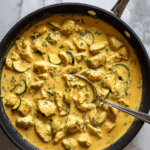
Coconut Milk Chicken
- Prep Time: 10 minutes
- Cook Time: 25 minutes
- Total Time: 35 minutes
- Yield: 4 servings 1x
- Category: Dinner
- Method: Stovetop
- Cuisine: Fusion
- Diet: Halal
Description
This Coconut Milk Chicken recipe features tender chicken breasts simmered in a rich, creamy tomato and coconut milk sauce, infused with warm spices. It’s a comforting, flavorful dish perfect for a weeknight dinner or entertaining guests.
Ingredients
- 1.5 pounds boneless, skinless chicken breasts, 1 to 1½ inch thick
- 1 teaspoon ground cumin
- 1 teaspoon smoked or sweet paprika
- 1 teaspoon dried oregano
- ½ teaspoon cayenne pepper (optional, adjust to taste)
- 1 to 1½ teaspoons salt, or to taste
- ¼ to ½ teaspoon freshly ground black pepper, or to taste
- 3 tablespoons olive oil, divided
- 1 small yellow onion, finely diced
- 3 cloves garlic, minced
- 1 tablespoon tomato paste
- 2 cups seeded and diced tomatoes, or 1 can (14 ounces) diced tomatoes, well drained
- 1 (14-ounce) can unsweetened coconut milk, shaken and stirred
- Chopped fresh cilantro, for garnish
- Lime wedges, for serving
Instructions
- Shake the coconut milk can well, then open and stir to combine. Pat chicken breasts dry with paper towels and set aside.
- In a small bowl, mix together cumin, paprika, oregano, cayenne pepper (if using), salt, and black pepper.
- Heat 2 tablespoons olive oil in a large skillet over medium heat. Rub seasoning mixture all over chicken breasts.
- Add the chicken to the skillet and cook for 6 to 7 minutes per side or until browned and nearly cooked through. Remove and set aside, keeping covered.
- Add the remaining 1 tablespoon olive oil to the same skillet. Add diced onions and cook for 2 to 3 minutes until tender and translucent.
- Stir in garlic and cook for 20 seconds. Add tomato paste and stir until well combined.
- Add diced tomatoes and cook for 5 minutes until softened.
- Stir in coconut milk and bring to a simmer. Simmer for 5 minutes until the sauce thickens slightly.
- Return chicken to the skillet. Reduce heat to medium-low and cook for an additional 4 to 5 minutes, or until chicken reaches an internal temperature of 165˚F.
- Taste the sauce and adjust salt and pepper as needed. Garnish with fresh cilantro and serve with lime wedges.
Notes
- For a spicier dish, increase cayenne pepper to 1 teaspoon.
- Use full-fat coconut milk for a richer sauce.
- This dish pairs well with steamed rice or warm naan.
- Leftovers can be stored in the fridge for up to 3 days.
Nutrition
- Serving Size: 1 chicken breast with sauce
- Calories: 390
- Sugar: 4g
- Sodium: 720mg
- Fat: 25g
- Saturated Fat: 14g
- Unsaturated Fat: 9g
- Trans Fat: 0g
- Carbohydrates: 9g
- Fiber: 2g
- Protein: 35g
- Cholesterol: 95mg
Keywords: coconut milk chicken, creamy chicken recipe, coconut chicken skillet, easy chicken dinner, spicy coconut chicken


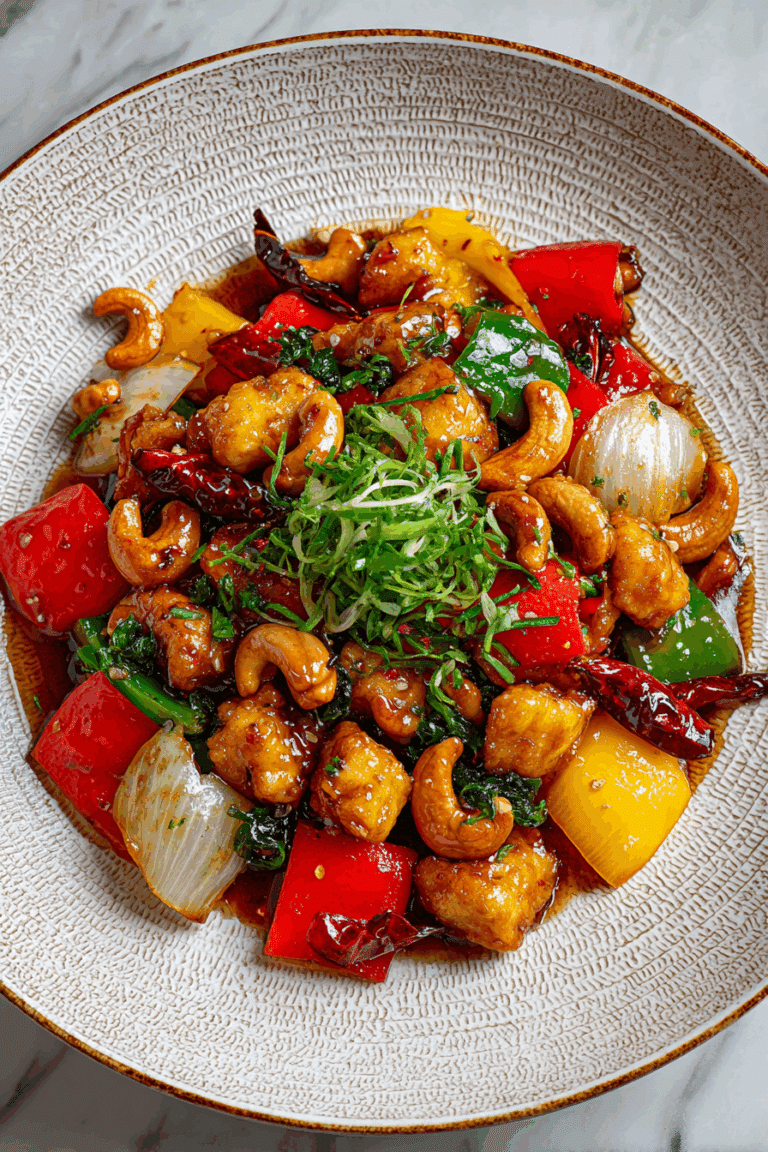

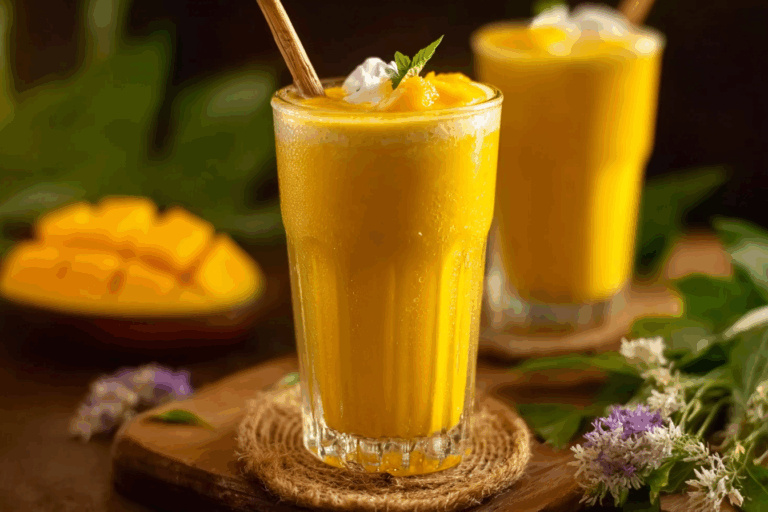
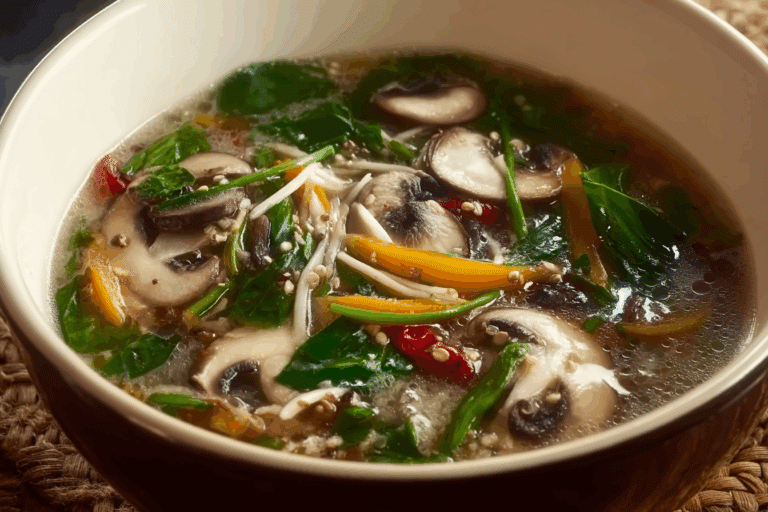


I enjoy foregathering useful info, this post has got me even more info! .